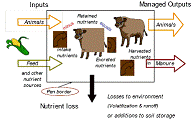Biological Systems Engineering, Department of

Department of Agricultural and Biological Systems Engineering: Presentations and White Papers
Date of this Version
2009
Document Type
Article
Abstract
Coastal bermudagrass is a promising lignocellulosic feedstock for bioethanol production. It is well suited for the Southeastern United States where it is currently grown for hay production and nutrient management in animal farming operations. Prior experiments have generated sugar and sugar degradation data from the dilute acid pretreatment and enzymatic hydrolysis of bermudagrass over a range of pretreatment conditions. Experimentally, the yield of total glucose and xylose was maximized at 93 % of the theoretical value for the pretreatment conditions 140 °C and 1.2 % sulfuric acid (w/w) for a residence time of 30 minutes. To explore further potential optimum pretreatment conditions, an artifical neural network (ANN) was created to model both the pretreatment and enzymatic hydrolysis steps using the prior experimental data to train it. The ANN took the only the three pretreatment conditions as inputs and output glucose from the enzymatic hydrolysis step, with an R2 of 0.97, xylose from the pre-hydrolyzate, with an R2 of 0.95, total glucose and xylose from both steps, with an R2 of 0.97, and furfural from the pre-hydrolyzate, with an R2 of 0.93. From the ANN, several optimal sets of pretreatment conditions were found with total glucose and xylose levels greater than 93% of the theoretical yield with the maximum being just under 100% for the conditions 150 °C and 0.9 % sulfuric acid (w/w) for a residence time of 30 minutes. A simple fermentation simulation reinforced the need for co-fermenting xylose and glucose.


Comments
An ASABE Meeting Presentation
Paper Number: 096007